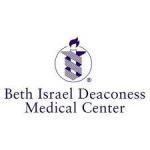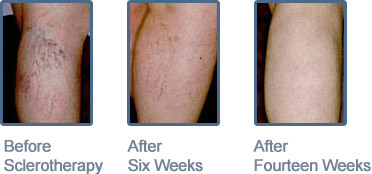Leg Vein Treatment
For leg vein treatment, Dermatology Associates of Southern New Hampshire decades of expertise in sclerotherapy, a proven method for reducing spider veins.
Spider veins are small enlarged superficial blood vessels that appear red or blue. They commonly occur on the legs, but frequently occur on the face or elsewhere.
These dilated blood vessels may be short, unconnected lines each about the size of a large hair or connected in a matted, “sunburst” pattern. They may also look like a spider web or a tree with branches. Sometimes, they occur in a small area and aren’t very noticeable, or they can cover a large area of skin and be quite unattractive.
Larger dilated blood vessels called varicose veins may be raised above the skin surface. They may occur along with spider veins.
Patients can have pain, ranging from a dull throbbing pain to a burning sensation. The larger vessels are more likely to cause discomfort, although smaller blue veins have been shown to cause pain.
If spider veins are unsightly or uncomfortable, they can be treated with laser or by injection of a solution that will cause them to disappear or become much smaller. There is about a 50 – 90 percent chance for a greatly improved appearance.
What causes these blood vessels to become visible?
The cause of spider veins is not completely known. In many cases they seem to run in families. Identical twins can be affected in the same area of the body and to the same extent. The condition rarely occurs as part of an internal disease.
Spider veins appear in both men and women, but more frequently in women. The female hormones may play a role in their development. Puberty, birth control pills, pregnancy or hormone replacement therapy often seem to bring them out. They may also appear after an injury or as a result of wearing tight girdles or hosiery held up with tight rubber bands. Spider veins may also occur in association with large varicose veins.
Spider veins on the nose or the cheeks of fair skinned persons may be related to sun exposure.
Can spider veins be prevented?
Spider veins can’t always be prevented. Wearing support hose may minimize unwanted blood vessels from developing. Keeping one’s weight at a normal level and exercising regularly may also be helpful. Eating a high-fiber diet and wearing low-heeled shoes may also help. Sun protection is important to limit the number of unwanted vessels on the face.
How are unwanted blood vessels on the legs treated?
The injection method, a procedure called sclerotherapy, is used to treat unwanted blood vessels. One of several kinds of solutions, called sclerosing solution, is injected with a very fine needle directly into the blood vessel. This procedure has been used for spider veins since the 1930’s and before that for larger veins. The solution irritates the lining of the vessel, causing it to swell and stick together and the blood to thicken. Over a period of weeks, the vessel turns into scar tissue that is absorbed, eventually becoming barely noticeable or invisible.
Sclerotherapy
A single blood vessel may have to be injected more than once, some weeks or months apart, depending on its size. In any one treatment session a number of vessels can be injected.
The solutions available are slightly different and the choice of which solution to use depends on several factors including the size of the vessel to be injected. Our dermatologist will choose a solution that is best for your particular case.
Occasionally larger varicose veins are underneath or associated with the spider veins. In such cases, some physicians believe these vessels should be treated before the spider veins. This can be done by sclerotherapy, intravascular laser, or radiofrequency, followed by compression.
How successful is sclerotherapy?
After several treatments, most patients can expect a 50 percent to 90 percent improvement. However, fading is gradual, usually over months. Disappearance of spider veins is usually achieved, but similar veins may appear in the same general area.
Can sclerotherapy or lasers be used on all skin types?
Yes. All skin types and skin colors respond equally well.
Will insurance cover the treatment of unwanted blood vessels?
Insurance rarely covers treatment of spider veins but may sometimes cover larger vain treatment. If the treatment is solely for cosmetic reasons, it may not be covered. Sometimes a second opinion, laboratory studies or photographs are required by insurance companies before treatment is started to get the procedure covered for larger varicose veins.
Are there side effects to spider vein treatments?
Even with a highly experienced physician performing the treatment, there are some possible side effects. They include:
- Stinging or pain at the sites of injection, swelling of the ankles or feet or muscle cramps – Some solutions for injection are relatively pain-free. Muscle cramps almost always occur when the injection solution is hypertonic saline. These usually go away within 10 to 15 minutes after injection.
- Red, raised areas at the sites of injection – These should disappear within a day or so and are like hives.
- Brown lines or spots on the skin at the sites of treated blood vessels – Probably made up of a form of iron in the blood, these darkened areas may result when blood escapes from treated veins. These dark areas occur more often in patients who have larger veins treated. In most cases, they disappear within 6 months to a year, but in a small percent of patients they may last longer. Laser treatment may cause skin discoloration.
- Development of groups of fine red blood vessels near the sites of injection of larger vessels, especially on the thighs – About a third of patients develop these; most disappear by themselves, some go away with additional injection treatment or laser therapy, a few may last.
- Small, painful ulcers at treatment sites either immediately or within a few days of injection – These occur when some of the solution escapes into the surrounding skin or enters a tiny artery at the treatment site. These can be successfully treated, but it is necessary to inform the physician of them immediately. Lasers may cause small areas of skin breakdown.
- Bruises at the site where the needle went into the skin – These will disappear in a few weeks and are probably related to the thinness of blood vessel walls.
- Allergic reactions to certain sclerosing solutions – Although such reactions can be serious, they are extremely rare and can be treated by your dermatologist. Minor reactions can be treated with antihistamines.
- Inflammation of treated blood vessels – This is very unusual but when it occurs it is treated with medications such as aspirin, compression, antibiotics or heat.
- Lumps in injected vessels, particularly larger ones, may develop – This is coagulated blood, similar to a bruise within the vein, but is not dangerous. The dermatologist may drain the blood out of these areas a few weeks after injection.
Will treated veins recur?
Larger veins may recur even after surgical procedures. Spider veins may also recur. It may seem that a previously injected vessel has recurred, when, in fact, a new spider vein has appeared in the same area.
Is a history of blood clots in the lungs or legs a reason to avoid therapy?
Not necessarily, but the procedure must be done with caution to lessen the risk of blood clots.
Are there other treatment methods?
For larger varicose veins, radiofrequency may be used instead of stripping. Great advances have been made in the use of ultrasound to guide injection of varicose veins not visible at the skin surface.
Surgically tying veins off (ligation) or pulling them out (ambulatory phlebectomy) are other procedures for treating unwanted blood vessels. These methods are usually reserved for larger varicose veins.
How are spider veins on the face treated?
There are several ways to treat spider veins on the face. Many different lasers and intense pulsed light have been used quite successfully.
What do I do after treatments?
Physicians may differ in their after-treatment instructions to patients. Most advise their patients to “pump” the sclerosing solution out of the circulation by walking following the procedure.
Some physicians bandage the injected areas and instruct patients to “compress” the treated vessels by wearing support hose. This may help seal the treated vessels, keep the blood from collecting under the skin and reduce the development of dark spots. It also may reduce the number of treatments necessary, and the possibility of recurrence. Others put tape dressings on the areas and do not use compression unless the veins are large or in special locations.
Between treatments, many physicians recommend the use of compression or support hose. This may be particularly recommended for people who spend a lot of time on their feet or work in a standing occupation.
The treatment of spider and varicose veins is typically successful. Treatment methods vary depending on the size and location of the abnormal veins. The injection method is presently most commonly used and is usually the most successful.


